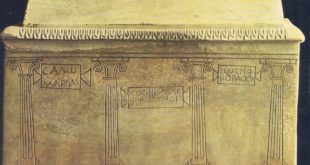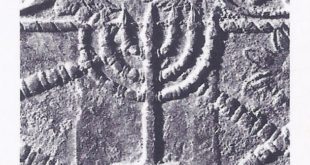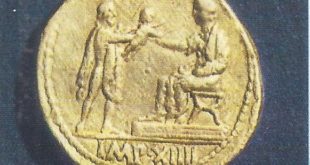Aryan peoples from the North descended into India, radically affecting the native civilization, round about between 1750 to 1400 B.C. Some four thousand years ago in India, around the Indus Valley at Mohenjo-daro and farther north at Harappa, a civilization flourished rivaling those of Egypt and Mesopotamia. Streets were laid out at right angles, brick houses existed and an elaborate drainage system was installed. Writing had also been invented. Pottery was produced and there were certainly trading contacts with Mesopotamia. They were not simply invaders — though archaeology has produced evidence of fighting at Mohenjo-daro — but settlers.
The Aryan invasions were infact migrations of peoples. Among other things they introduced the horse — hitherto unknown — to India, but much more significantly, they brought a new language and a new religion, whose effects are still profoundly important in India today.
The Indian subcontinent, bounded on the north by the mountain ranges of the Himalayas and elsewhere by the ocean, has always been relatively immune from invasion. The would-be invader must show an extraordinary degree of resourcefulness and tenacity if such natural obstacles as these are to be overcome. On only two occasions in historical times has India been invaded: by the armies of Islam in the Middle Ages and by the British (a process of gradual infiltration rather than direct invasion) in the eighteenth and nineteenth centuries. Of the “prehistoric” invasions, that of the Aryans in the second half of the second millennium B.C. has left the profoundest marks on Indian culture and may fairly be called a milestone in Indian history.
The precise dates and conditions of the Aryan invasion, for reasons we shall discuss later, may still elude scholarship, but this much is clear, between 1750 and 1400 B.C. India was forced to meet the onslaughts of waves of nomadic “barbarians” from the northwest. Materially, the nomads were far inferior to the peoples they were in the process of conquering; spiritually, they were perhaps not inferior, but they were certainly different.
The process of conquest, which appears to have been gradual rather than sudden, as successive tribes or groups of tribes crossed the mountains into the Indus Valley and the Punjab, was greatly facilitated by the Aryans’ greater mobility, in which the domestication of the horse played a great part. It cannot be stressed enough that this did not mean that the original inhabitants of the occupied area were simply exterminated. They were displaced or subdued; patterns of thought and conduct were imposed on them; and by the time of the Aryans’ further migration into the Gangetic basin and western Central India, Aryan ideals were certainly dominant in those areas. Farther south and east, Aryanization was both gradual and incomplete; and it remains so to this day.
If history can be said to begin with the emergence of chronicles and other written sources, then the Aryan invasion belongs to prehistory. This is not to say that there is no accessible material from which knowledge of the invasion may be derived. Such material is of two kinds: oral-literary, the hymns of the Rig Veda, not reduced to writing until many centuries after the events they reflect but preserved with minute accuracy down through the ages; and archaeological, a constantly growing body of information that may yet require us seriously to modify many accepted opinions and many more tacit assumptions.
Neither source is absolutely precise or completely exhaustive. Literary material such as the Rig Veda, apart from not being susceptible to precise dating or location, is thoroughly partisan. Take, for instance, this quotation from a hymn dedicated to the warrior god Indra:
With all-outstripping chariot-wheel, Indra, thou
Far-famed, hast overthrown
the twice ten kings of men
With sixty thousand nine and ninety followers . . .
Thou goest on from fight to fight intrepidly
Destroying castle after
castle here with strength.
(Rig Veda 1:53)
The impression given by these and similar verses is of a campaign of conquest and destruction; not unnaturally, the hymns speak of the conquered peoples only in terms of contempt. In contrast to the light-skinned “nobles,” they were dark, snub-nosed barbarians (in the sense of speaking an unintelligible language); contemptible phallus worshippers who were nevertheless wealthy, with cattle, fields and fortified cities. If they were destroyed by the “nobles,” it was no more than they deserved: such is the impression given by the Aryans’ own literary sources.

A Flourishing Native Culture
Until fairly recently, although it might have been suspected that this was not the whole truth, historians took the evidence of the Rig Veda literally. Indian culture, it was assumed, was a product of the Aryan mind, modified in the direction of inactivity and contemplation (the two unjustly equated) by long residence on the Indian plains. The pre-Aryan strain in the Indian population could not, it was thought, have contributed anything of value. True, this left historians and not least historians of religion, with many uncomfortable facts to explain away; but the validity of what the Rig Veda had to say about the people the Aryans found in India was not questioned. In his book Indian Philosophy (1923), Radhakrishnan was thus able to write: “When the Aryans came to India they found the natives of India whom they called Dasyus (a word of uncertain meaning) opposing their free advance. These Dasyus were of a dark complexion, eating beef and indulging in Goblin worship. When the Aryans met them they desired to keep themselves aloof from them. When these words were written, it really seemed as though the natives of northwest India were no more than a rabble of aboriginal savages.

Over the last half century, thanks to archaeology, our picture of the Aryan invasions has to be completely revised. The reassessment (“revolution” might not be too strong a word) came early in the 1920’s with the beginning of excavations at two sites: Harappa, in the Punjab, some 100 miles southwest of Lahore and Mohenjo-daro (“the mound of the dead”), on the River Indus in Sind, two hundred miles north of Karachi. Since then further excavation over a very wide area has confirmed the fact that during the third and second millennia B.C. northwest India was the home not of barbarism but of a flourishing and in some ways extremely sophisticated urban culture, not unlike that of Mesopotamia. This is now known variously as the Indus Culture, the Harappa Culture and the Indus Valley Civilization. Some seventy sites are now known, covering an area of about half a million square miles. One of the most striking features of the Indus Culture is its elaborate and consistent practical development. This extends to such details as weights and measures. town planning, architecture, drainage, pottery, trade, commerce, art and (apparently) religion. As far as we know, Harappa and Mohenio-daro were the main centres, but we have no way of telling whether they were provincial or local capitals. Despite such gaps in our knowledge, it is clear it the Indus Culture was far more advanced in practical ways than that of the invading nomadic Aryans. Spiritually, too, there is every reason to believe that the Indus Culture contributed much more to Hinduism than scholars were once prepared to allow.

One of the most celebrated finds from Mohenjo-daro is a seal bearing the image of a horned, three-faced male deity, seated in a yogic position and surrounded by animals — elephant, tiger, bull, rhinoceros and goat. This is evidently a prototype f the great god Shiva, lord of the beasts and prince of Yogins. Also connected with the worship of Shiva is the phallic symbol, or lingam, many representations of which have been found on Indus Culture sites. Many figures of nude or semi-nude females have also been found, explicable only as examples of the great mother goddess still worshiped by various names all over India. The most spectacular building excavated at Mohenjo-daro — the “great bath” — probably points to the early practice of ritual washing, such as is still observed today in sacred rivers and temple baths in all parts of India. The overriding impression of the spiritual basis of the Indus Culture provided by archaeology is of a fertility religion: man’s attempt to come to terms with the realities of his agrarian existence. Insofar as agriculture has remained the main basis of the Indian economy and way of life, Indian spiritual culture, still rooted to the soil, has taken over the heritage of the Indus Culture.
We must not, however, be too categorical when speaking of the intellectual aspects of the Indus Culture. There was a written language, but as yet no attempt to decipher the Indus script has met with undisputed success. It is thought that the language was probably Dravidian, perhaps therefore an ancestor of modern Tamil, but until a bilingual inscription is found perhaps in Sumer? — the thought of pre-Aryan bronze age India remains obstinately inaccessible.


Even the dates of the Indus Culture are a matter of dispute. It would probably not be too inaccurate to think in terms of an overall span of about a thousand years, from about 2500 to about 1500 B.C., since it is known that important trade contacts with Mesopotamia took place between 2300 and 2000 B.C., and radiocarbon dates have been obtained varying between 2300 and 1750 B.C. It seems relatively certain, however, that a decline began in about 1750 B.C. and that this decline and fall was in some way connected with the coming of the Aryans from the northwest.
Did the Aryans merely administer the final blows to a civilization already in decline? The evidence on this point is inconclusive. While in some areas the end of the Indus Culture seems to have been accompanied by extreme violence, elsewhere the transition may have been fairly peaceful. At Mohenjo-daro, the finding of unburied skeletons in the streets points unmistakably to unexpected attack from some quarter; at Harappa, on the other hand, the evidence seems to suggest that peaceful settlement took place. Much has been made of changing climatic conditions as a factor contributing to the weakened state of the Indus Culture at that time, but we do not know how far it had declined when the first Aryan incursions began. What we do know is that, in two closely related areas of its culture, India was decisively affected by the invaders. The first of these is language; the second, religion.

Aryan Culture – A New People from the North
The Aryan language belonged to the type classified later as Indo-European. The hieratic language of their religion was Sanskrit; the spoken language was probably one of the dialects related to Sanskrit, of the type since called Prakrits. The Indus language, on the other hand, was probably Dravidian, belonging to an entirely different linguistic family. Within a few centuries, Sanskrit was established as the sacred and official language of northern India: the language of hymns, prayers and commentaries, epics and lyrics, codes of religious and secular law. Belonging to the Prakrits group is Pali, the sacred language of Buddhism; among direct descendants of Sanskrit are modern Hindi, Bengali, Marathi and Gujarati. Hence, in a real sense, the linguistic consequences of the Aryan invasion are still with us. Attempts undertaken in north India successfully established Hindi as the official language of the whole of India — attempts partly motivated by its direct descent from Sanskrit have been objected to by Dravidian-speaking southern Indians in particular as “north Indian imperialism.” It is an incontestable fact that classical Indian culture expressed itself very largely in the tongue of the Aryans.

The religion of the Aryans was essentially different from that of the Indus peoples. The latter followed a fertility religion, based largely on the earth as giver of life. Aryan religion was centered on the great deities of the sky, atmosphere, sun, moon, storm and fire. The earliest Indian religious writings, the hymns of the Rig Veda, were probably in part brought into India by later waves of Aryan invaders and in part composed after the invasions. They reflect a priestly religion, concerned above all with the maintenance of the natural order, ria, by regular sacrifice. Many hymns are dedicated to the god of storm and war, Indra, to the god of the sacrificial fire, Agni and to the deified sacrificial drink, Soma, as well as to the more remote celestial gods, Varuna and Vishnu. The Brahmanas, prolix commentaries on the hymns showing sacrificial theory and practice, probably date from the beginning of the iron age and the second stage of the invasions. The Upanishads, mystical treatises concerning man and the universe, reflect some of the earliest stirrings of the Indian speculative mind, possibly as a result of contact with Indus beliefs. On these foundations, though with many later elaborations, rests the complex edifice of Hinduism in its priestly aspect. To this day, one test of Hindu orthodoxy is the acceptance of the divine authority of these Vedic scriptures largely, if not entirely, Aryan products.

Hinduism, however, is a social as well as a religious phenomenon and there is probably no more tenacious social institution in the world than that of caste — still very much in existence in India. It has been very extensively modified over the centuries, but that its roots date back to the Aryan invasion cannot be doubted. In the past, it has been too readily assumed that caste originated as a simple colour bar between light-skinned Aryans and dark-skinned Dravidians, but this overlooks the fact that three of the four main caste groupings, those of priests, warriors and artisans, were classified as “twice-born,” i.e. Aryan; only the fourth, the serfs, appear to have been non-Aryan. In fact, basic caste structure can be shown to correspond closely to the traditional structure of Aryan society: corroborative evidence can be found among other Indo-European peoples, such as the Celts and Romans. The conclusion must be that the invaders brought a rudimentary form of the caste system with them and that after the invasions the conquered peoples were relegated in most cases to a subordinate role in society as serfs. In time, the emergent Indian society became more and more rigidly stratified under the growing influence of the Brahmanical priesthood — an influence that has persisted to modern times.

Down the centuries, the social and religious structure of Indian society became Aryanized in accordance with varnasrama dharma, i.e. the caste law. To be a good Hindu and by implication a good Indian, it was necessary to observe the laws of one’s caste, as laid down in the priestly codes, such as the Laws of Manu. Language, trade and commerce, secular jurisprudence and education similarly followed Aryan patterns.

This is not to say that India has ever become completely Aryanized. The contrast between the Aryan north and the Dravidian south is still marked and India’s conflicts are still to some extent unresolved. Hinduism, although its superstructure and many of its philosophies are derived directly from the Vedic Aryans, is noticeably non-Aryan at the popular, grass-root level. For the culture of India is a complex and composite entity, reducible to no simple categories and intolerant of simple explanations. India proved hospitable to the Aryan invaders of three thousand years ago; their coming altered the entire pattern of her future history, but the fact that it is still impossible to read India’s history solely in Aryan terms demonstrates clearly that she did not entirely submit to the invasion.



























